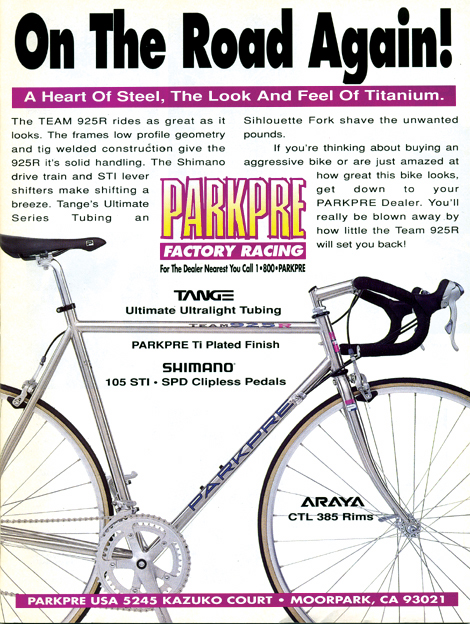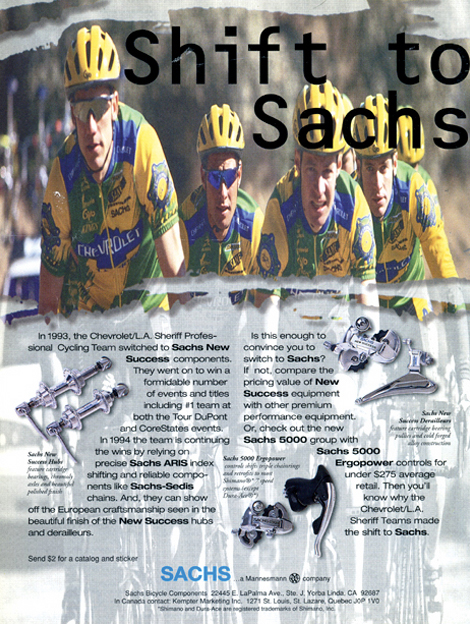Road Bike Action decided to take a look back to the era of neon, front suspension and the arrival of Lance Armstrong. Road Bike Action has complied a collection of ads from the 1990s to see what the industry looked like three decades ago.

In 1993, Castelli used the biggest name in the sport and Tour de France champion Miguel Indurain to sell its clothing. Today, Castelli continues to sponsor many of the sports top riders and teams.

ParkPre was a successful mountain bike company that tried to crossover to the road market. They were hit hard by the decline in the mountain market that followed the 1996 Olympics and eventually faded from the US market.

The legendary Oakley M frames. First made famous by Greg LeMond, the M Frames became the industry leader in the 1990s. The Oakley M Frames continue today but have been replaced at the top of Oakley’s line by the new industry leading Radar.

PowerBar was the original energy bar. This one product launched an entire industry which has branched out from endurance sports with energy bars now available from bike shops to grocery stores and even the local 7-11.

Camelbak is another mountain bike company that tried to crossover but found limited success in the road market. Today Camelbaks are standard equipment for many gravel and mountain bike riders.

Ringl was a highly successful mountain bike company, known for lightweight and colorfully anodized aluminum parts. They were less successful on the road scene as traditionalist didn’t take to the idea of adding anodized parts to their bikes. Ringl eventually merged was Sunn rims and made high-end road wheels.

In 1994, Carnac used Tour de France riders Richard Virenque and Luc LeBlanc to sell their road shoes in America. Unfortunately for Carnac, both riders would be involved in doping scandals a few years later.

In the mid 1990’s, GT hit the road market was a vengeance coming out with a full line of steel, aluminum and titanium bicycles. GT would also sponsor the US National team, build bikes for the 1996 Olympics and sponsor the Belgian Lotto team.

GT was big part of Project 96, a development program for the 1996 Olympics. The project 96 program did a lot for advancing the understanding of aerodynamics in regard to bicycles and led to some of the more successful time trial and track bikes of the decade.

In the 1990’s the race for the hour record was again brought to the sports forefront with riders like Tony Rominger, Miguel Indurain, Chris Boardman and Graeme Obree all taking their turn at holding the record. Panaracer’s sponsorship of Obree shows the level interest the hour record at the time. The UCI effectively killed the public’s interest in the hour record by placing limits on bicycle design and rider positions. They even went as far a reverting the hour record back to the time set by Eddy Merckx.

After a victories in the 1993 and 1994 editions of Paris Roubaix, Rock Shox brought the Paris Roubaix Road SL and later the Ruby to the market. The forks struggled to find a niche in the market and the idea of suspension forks for road bikes has been abandoned, however gravel has found a newfound niche for drop-bar front-end cush.

Sidi introduced the Sidi Tecno, based off the Genius 2. The Tecno evolved into the Ergo 2 and the Genius series continues with the Genius 10.

Spinergy wheels hit the market and changed the way people thought about wheel design. The Rev-X were light and aero, but developed a reputation for catastrophic failures. Spinergy continues today building high-end wheels.

One of the more unique ad campaign of the 1990s was Vetta’s ‘Vetta Man.’ The campaign centered on future archaeologists that unearth a cyclist of the 1990s wearing a Vetta helmet and sunglasses.

Continental uses its success on the race course to the sell their tires. In 1995, the focus for most manufacturers was success at the upcoming Atlanta games.

GT used the slogan ‘my booties are barkin.’ The 1990s came and went without anyone figuring out what they were talking about.

The legendary John Howard teamed up with Steve Hed, Leonard Zinn, Boone Lennon and KHS to develop the ZH2H. At the time it was one of the most aerodynamic bikes with a double diamond design. The aero tubing, and curved seat tube were ahead of their time for a mass produced bicycles.

Klein was a pioneer of oversized aluminum frames. The bikes where highly sought after for their beautiful welds and colorful paint schemes. Klein was bought by Trek and eventually closed its doors as carbon took over the high-end market.

Sachs New Success was the company’s last effort to compete with Shimano and Campagnolo. Despite respectable performance the New Success did not sell. Sachs was purchased by SRAM in 1997.

Specialized uses Lance Armstrong’s mother to sell its Air Piranha Helmet. At the time Specialized was the helmet supplier for Armstrong’s Motorola team. The Air Piranha featured unique design touches like small teeth in the front vent and a fin on the back.

Another Specialized ad. This was is for their M2 Team road Bike. The Specialized M2 Team used a metal matrix composite frame and was available with Mavic’s electric Zap shifting.

In the 1990’s Time and Look fought for the Lion’s share of the clipless pedal market. Time used their low foot to pedal axle distance as their main selling point in this 1995 ad.

The 1990’s saw the emergence of dual compound tires. The Vittoria Tecno Twin tread would be become a stable of the Vittoria line. The rider at the bottom of the ad is Mario Cipollini, at the time a rising star in Italian cycling.



Comments are closed.